Comprehensive Report on Radioactivity in Physics (A-Level)
VerifiedAdded on 2021/02/19
|7
|1207
|180
Report
AI Summary
This report provides a comprehensive overview of radioactivity, a crucial concept in A-Level Physics. It begins with an introduction to radiation and its origins, stemming from unstable atoms seeking stability. The report then details the three primary types of radioactive decay: alpha, beta (including both beta-minus and beta-plus), and gamma decay, elaborating on the processes involved in each. Characteristics of each type of radiation, including their symbols, mass, charge, penetration power, shielding requirements, and common sources are compared in a table. The report further explains the origins of radiation, its penetration abilities, and energy deposition mechanisms, alongside the measurement units used in radiation physics. Calculations involving radiation dose and the importance of these calculations are discussed. The report concludes with a section on the safe handling and usage of radiation sources in various applications, emphasizing the necessity of safety considerations to minimize risks to both individuals and the environment. The report references various sources, including books and journals, to support the information provided.
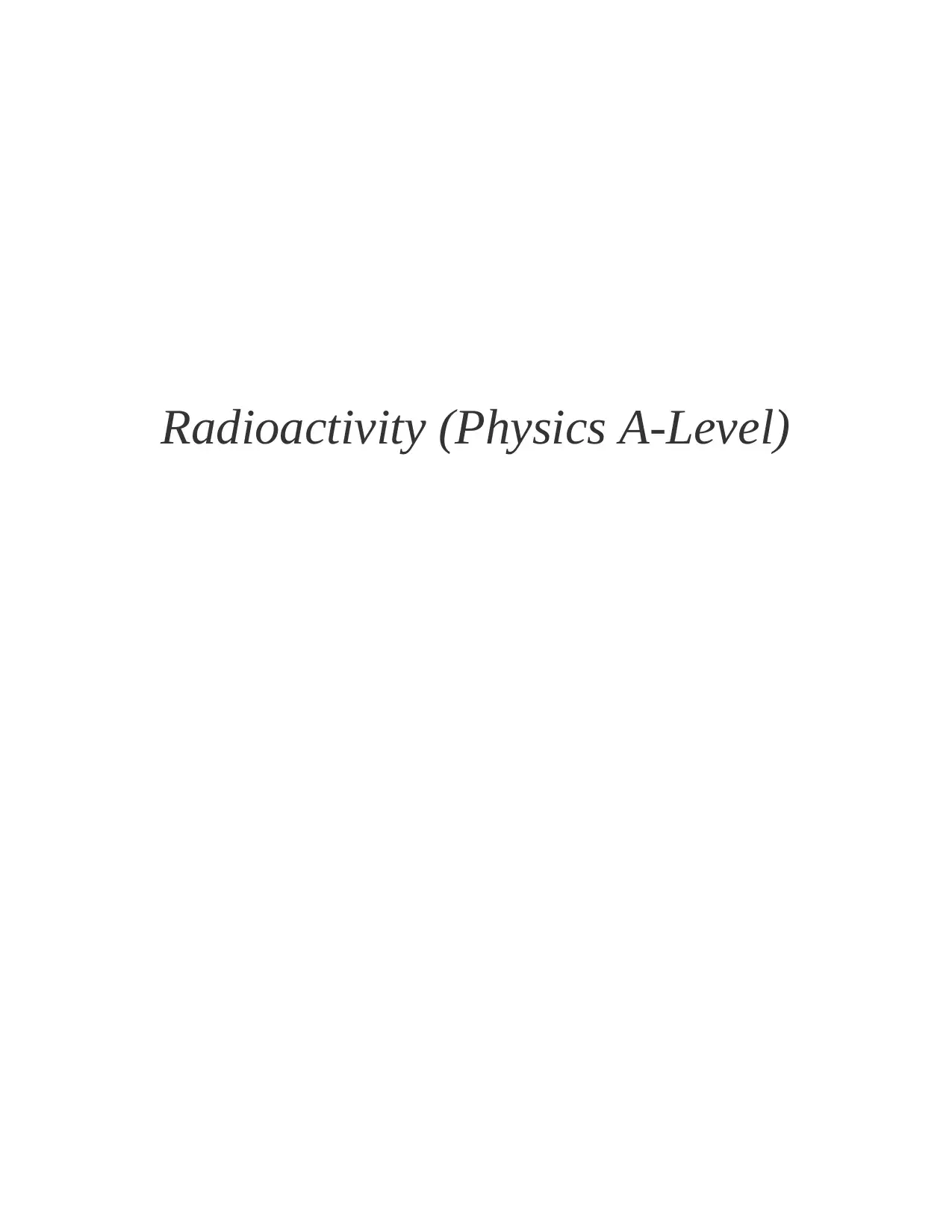
Radioactivity (Physics A-Level)
Paraphrase This Document
Need a fresh take? Get an instant paraphrase of this document with our AI Paraphraser
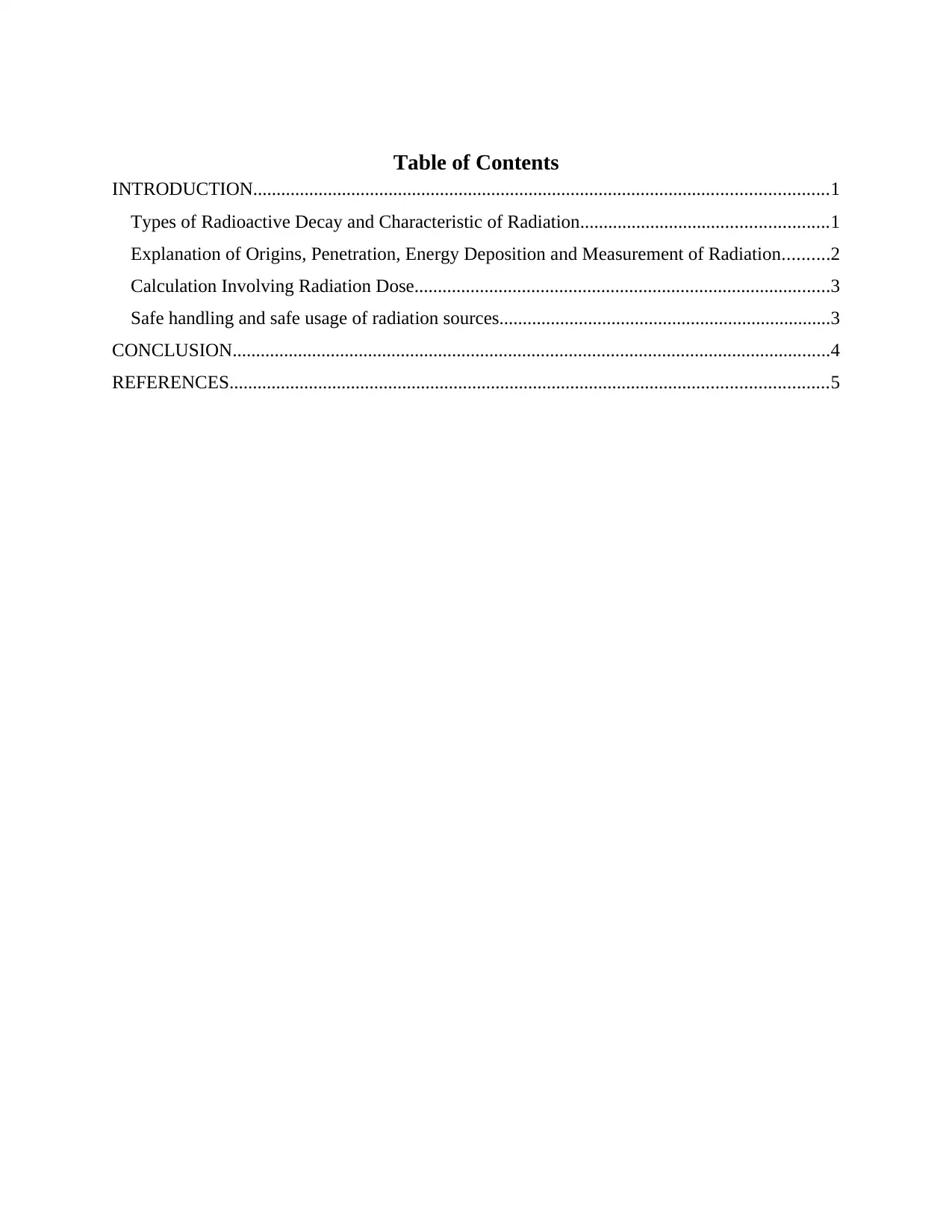
Table of Contents
INTRODUCTION...........................................................................................................................1
Types of Radioactive Decay and Characteristic of Radiation.....................................................1
Explanation of Origins, Penetration, Energy Deposition and Measurement of Radiation..........2
Calculation Involving Radiation Dose.........................................................................................3
Safe handling and safe usage of radiation sources.......................................................................3
CONCLUSION................................................................................................................................4
REFERENCES................................................................................................................................5
INTRODUCTION...........................................................................................................................1
Types of Radioactive Decay and Characteristic of Radiation.....................................................1
Explanation of Origins, Penetration, Energy Deposition and Measurement of Radiation..........2
Calculation Involving Radiation Dose.........................................................................................3
Safe handling and safe usage of radiation sources.......................................................................3
CONCLUSION................................................................................................................................4
REFERENCES................................................................................................................................5
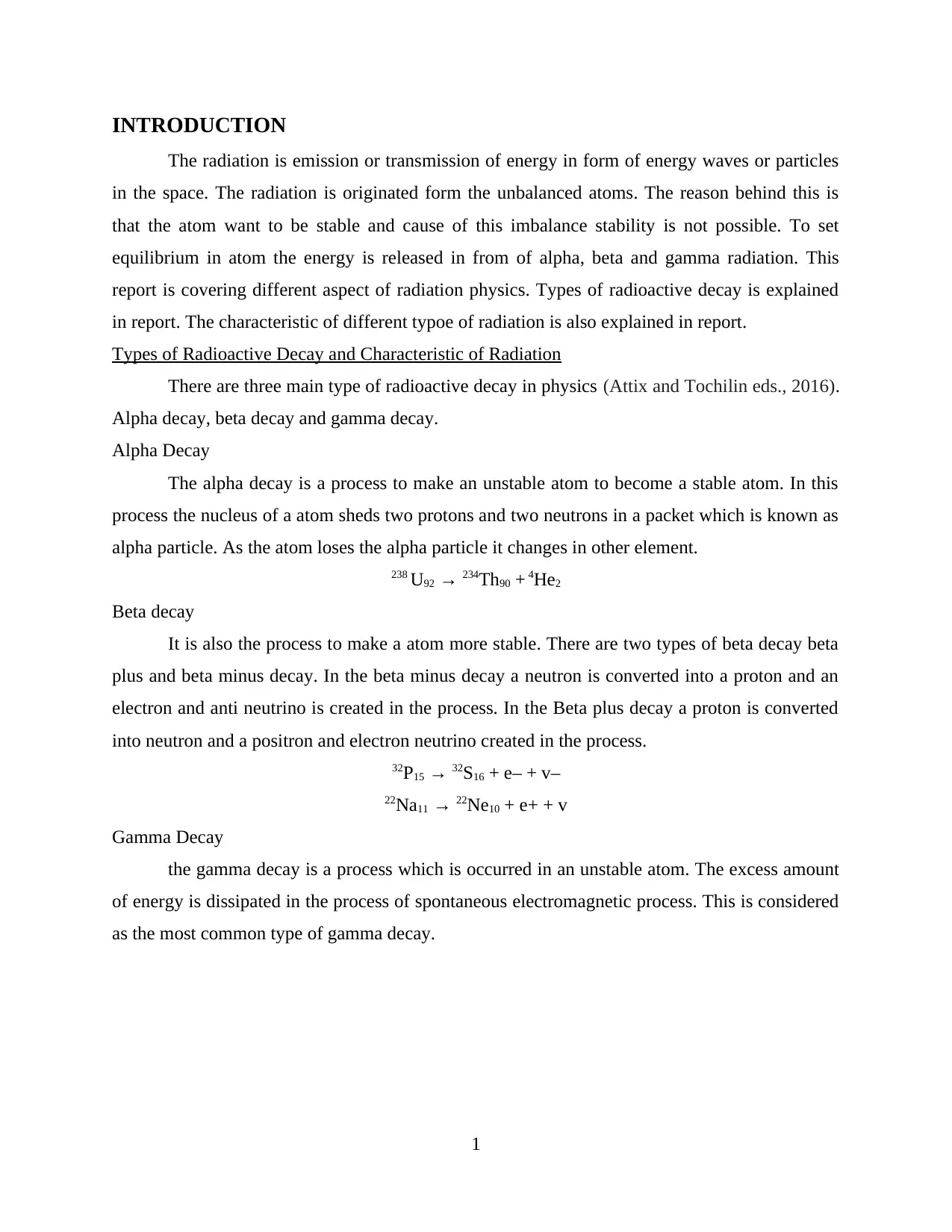
INTRODUCTION
The radiation is emission or transmission of energy in form of energy waves or particles
in the space. The radiation is originated form the unbalanced atoms. The reason behind this is
that the atom want to be stable and cause of this imbalance stability is not possible. To set
equilibrium in atom the energy is released in from of alpha, beta and gamma radiation. This
report is covering different aspect of radiation physics. Types of radioactive decay is explained
in report. The characteristic of different typoe of radiation is also explained in report.
Types of Radioactive Decay and Characteristic of Radiation
There are three main type of radioactive decay in physics (Attix and Tochilin eds., 2016).
Alpha decay, beta decay and gamma decay.
Alpha Decay
The alpha decay is a process to make an unstable atom to become a stable atom. In this
process the nucleus of a atom sheds two protons and two neutrons in a packet which is known as
alpha particle. As the atom loses the alpha particle it changes in other element.
238 U92 → 234Th90 + 4He2
Beta decay
It is also the process to make a atom more stable. There are two types of beta decay beta
plus and beta minus decay. In the beta minus decay a neutron is converted into a proton and an
electron and anti neutrino is created in the process. In the Beta plus decay a proton is converted
into neutron and a positron and electron neutrino created in the process.
32P15 → 32S16 + e– + v–
22Na11 → 22Ne10 + e+ + v
Gamma Decay
the gamma decay is a process which is occurred in an unstable atom. The excess amount
of energy is dissipated in the process of spontaneous electromagnetic process. This is considered
as the most common type of gamma decay.
1
The radiation is emission or transmission of energy in form of energy waves or particles
in the space. The radiation is originated form the unbalanced atoms. The reason behind this is
that the atom want to be stable and cause of this imbalance stability is not possible. To set
equilibrium in atom the energy is released in from of alpha, beta and gamma radiation. This
report is covering different aspect of radiation physics. Types of radioactive decay is explained
in report. The characteristic of different typoe of radiation is also explained in report.
Types of Radioactive Decay and Characteristic of Radiation
There are three main type of radioactive decay in physics (Attix and Tochilin eds., 2016).
Alpha decay, beta decay and gamma decay.
Alpha Decay
The alpha decay is a process to make an unstable atom to become a stable atom. In this
process the nucleus of a atom sheds two protons and two neutrons in a packet which is known as
alpha particle. As the atom loses the alpha particle it changes in other element.
238 U92 → 234Th90 + 4He2
Beta decay
It is also the process to make a atom more stable. There are two types of beta decay beta
plus and beta minus decay. In the beta minus decay a neutron is converted into a proton and an
electron and anti neutrino is created in the process. In the Beta plus decay a proton is converted
into neutron and a positron and electron neutrino created in the process.
32P15 → 32S16 + e– + v–
22Na11 → 22Ne10 + e+ + v
Gamma Decay
the gamma decay is a process which is occurred in an unstable atom. The excess amount
of energy is dissipated in the process of spontaneous electromagnetic process. This is considered
as the most common type of gamma decay.
1
⊘ This is a preview!⊘
Do you want full access?
Subscribe today to unlock all pages.

Trusted by 1+ million students worldwide
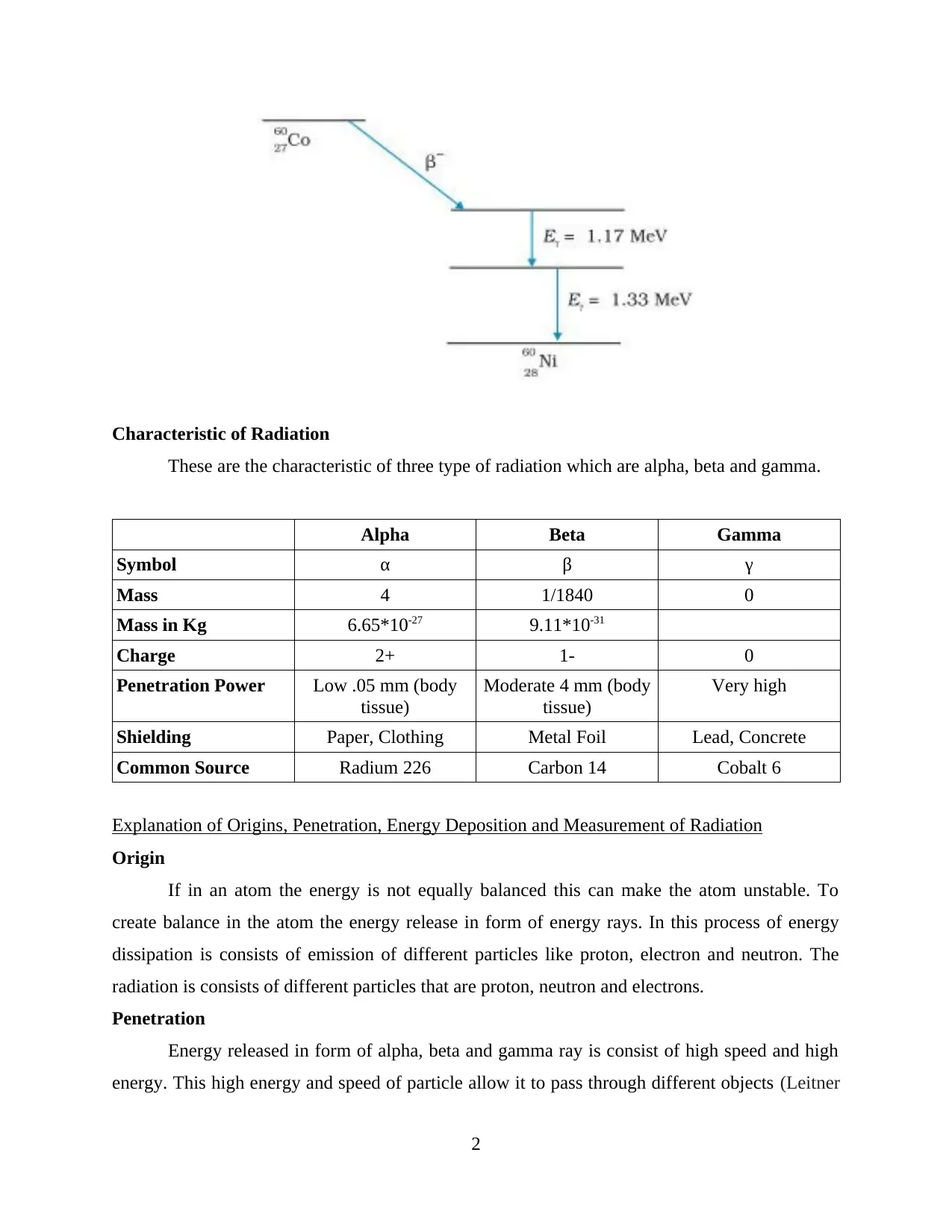
Characteristic of Radiation
These are the characteristic of three type of radiation which are alpha, beta and gamma.
Alpha Beta Gamma
Symbol α β γ
Mass 4 1/1840 0
Mass in Kg 6.65*10-27 9.11*10-31
Charge 2+ 1- 0
Penetration Power Low .05 mm (body
tissue)
Moderate 4 mm (body
tissue)
Very high
Shielding Paper, Clothing Metal Foil Lead, Concrete
Common Source Radium 226 Carbon 14 Cobalt 6
Explanation of Origins, Penetration, Energy Deposition and Measurement of Radiation
Origin
If in an atom the energy is not equally balanced this can make the atom unstable. To
create balance in the atom the energy release in form of energy rays. In this process of energy
dissipation is consists of emission of different particles like proton, electron and neutron. The
radiation is consists of different particles that are proton, neutron and electrons.
Penetration
Energy released in form of alpha, beta and gamma ray is consist of high speed and high
energy. This high energy and speed of particle allow it to pass through different objects (Leitner
2
These are the characteristic of three type of radiation which are alpha, beta and gamma.
Alpha Beta Gamma
Symbol α β γ
Mass 4 1/1840 0
Mass in Kg 6.65*10-27 9.11*10-31
Charge 2+ 1- 0
Penetration Power Low .05 mm (body
tissue)
Moderate 4 mm (body
tissue)
Very high
Shielding Paper, Clothing Metal Foil Lead, Concrete
Common Source Radium 226 Carbon 14 Cobalt 6
Explanation of Origins, Penetration, Energy Deposition and Measurement of Radiation
Origin
If in an atom the energy is not equally balanced this can make the atom unstable. To
create balance in the atom the energy release in form of energy rays. In this process of energy
dissipation is consists of emission of different particles like proton, electron and neutron. The
radiation is consists of different particles that are proton, neutron and electrons.
Penetration
Energy released in form of alpha, beta and gamma ray is consist of high speed and high
energy. This high energy and speed of particle allow it to pass through different objects (Leitner
2
Paraphrase This Document
Need a fresh take? Get an instant paraphrase of this document with our AI Paraphraser
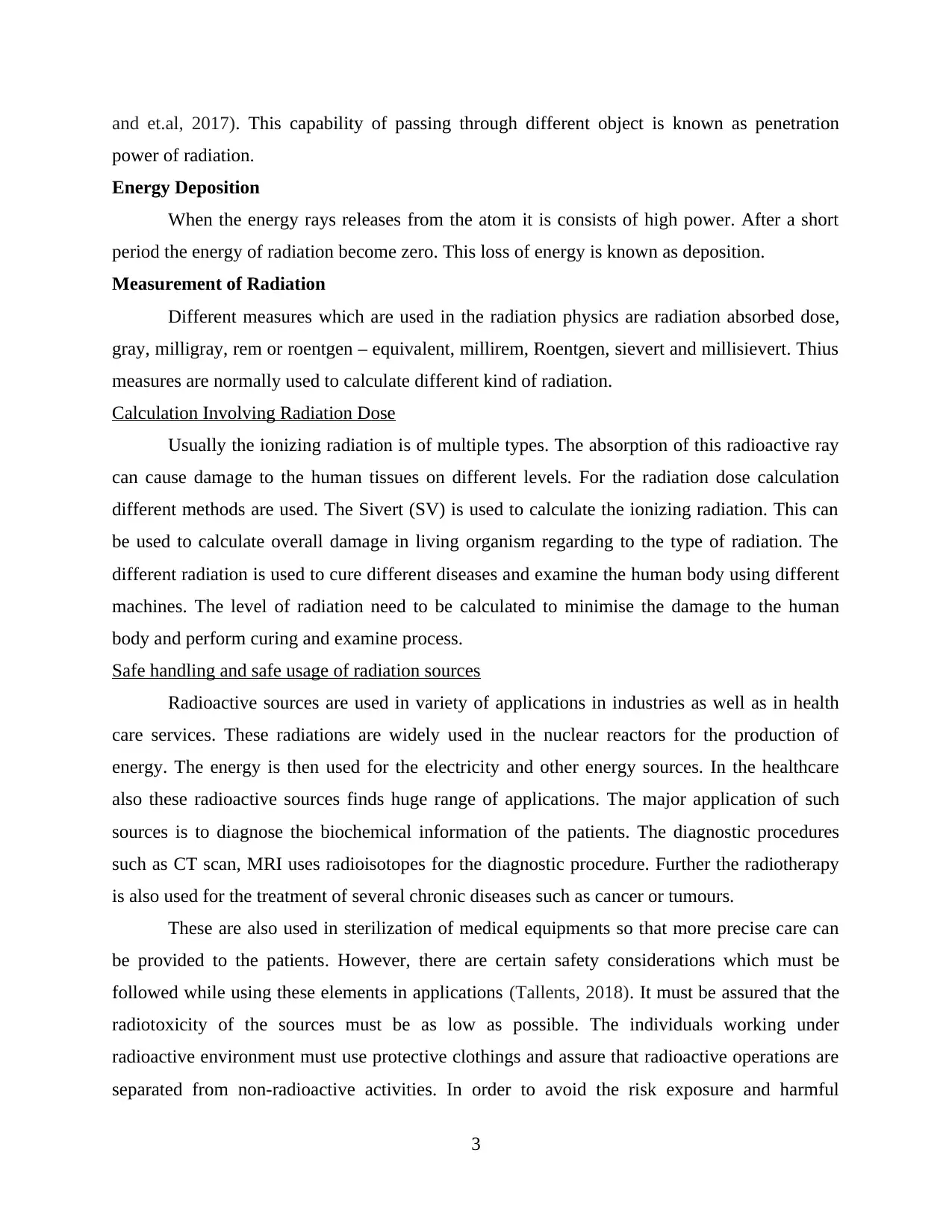
and et.al, 2017). This capability of passing through different object is known as penetration
power of radiation.
Energy Deposition
When the energy rays releases from the atom it is consists of high power. After a short
period the energy of radiation become zero. This loss of energy is known as deposition.
Measurement of Radiation
Different measures which are used in the radiation physics are radiation absorbed dose,
gray, milligray, rem or roentgen – equivalent, millirem, Roentgen, sievert and millisievert. Thius
measures are normally used to calculate different kind of radiation.
Calculation Involving Radiation Dose
Usually the ionizing radiation is of multiple types. The absorption of this radioactive ray
can cause damage to the human tissues on different levels. For the radiation dose calculation
different methods are used. The Sivert (SV) is used to calculate the ionizing radiation. This can
be used to calculate overall damage in living organism regarding to the type of radiation. The
different radiation is used to cure different diseases and examine the human body using different
machines. The level of radiation need to be calculated to minimise the damage to the human
body and perform curing and examine process.
Safe handling and safe usage of radiation sources
Radioactive sources are used in variety of applications in industries as well as in health
care services. These radiations are widely used in the nuclear reactors for the production of
energy. The energy is then used for the electricity and other energy sources. In the healthcare
also these radioactive sources finds huge range of applications. The major application of such
sources is to diagnose the biochemical information of the patients. The diagnostic procedures
such as CT scan, MRI uses radioisotopes for the diagnostic procedure. Further the radiotherapy
is also used for the treatment of several chronic diseases such as cancer or tumours.
These are also used in sterilization of medical equipments so that more precise care can
be provided to the patients. However, there are certain safety considerations which must be
followed while using these elements in applications (Tallents, 2018). It must be assured that the
radiotoxicity of the sources must be as low as possible. The individuals working under
radioactive environment must use protective clothings and assure that radioactive operations are
separated from non-radioactive activities. In order to avoid the risk exposure and harmful
3
power of radiation.
Energy Deposition
When the energy rays releases from the atom it is consists of high power. After a short
period the energy of radiation become zero. This loss of energy is known as deposition.
Measurement of Radiation
Different measures which are used in the radiation physics are radiation absorbed dose,
gray, milligray, rem or roentgen – equivalent, millirem, Roentgen, sievert and millisievert. Thius
measures are normally used to calculate different kind of radiation.
Calculation Involving Radiation Dose
Usually the ionizing radiation is of multiple types. The absorption of this radioactive ray
can cause damage to the human tissues on different levels. For the radiation dose calculation
different methods are used. The Sivert (SV) is used to calculate the ionizing radiation. This can
be used to calculate overall damage in living organism regarding to the type of radiation. The
different radiation is used to cure different diseases and examine the human body using different
machines. The level of radiation need to be calculated to minimise the damage to the human
body and perform curing and examine process.
Safe handling and safe usage of radiation sources
Radioactive sources are used in variety of applications in industries as well as in health
care services. These radiations are widely used in the nuclear reactors for the production of
energy. The energy is then used for the electricity and other energy sources. In the healthcare
also these radioactive sources finds huge range of applications. The major application of such
sources is to diagnose the biochemical information of the patients. The diagnostic procedures
such as CT scan, MRI uses radioisotopes for the diagnostic procedure. Further the radiotherapy
is also used for the treatment of several chronic diseases such as cancer or tumours.
These are also used in sterilization of medical equipments so that more precise care can
be provided to the patients. However, there are certain safety considerations which must be
followed while using these elements in applications (Tallents, 2018). It must be assured that the
radiotoxicity of the sources must be as low as possible. The individuals working under
radioactive environment must use protective clothings and assure that radioactive operations are
separated from non-radioactive activities. In order to avoid the risk exposure and harmful
3
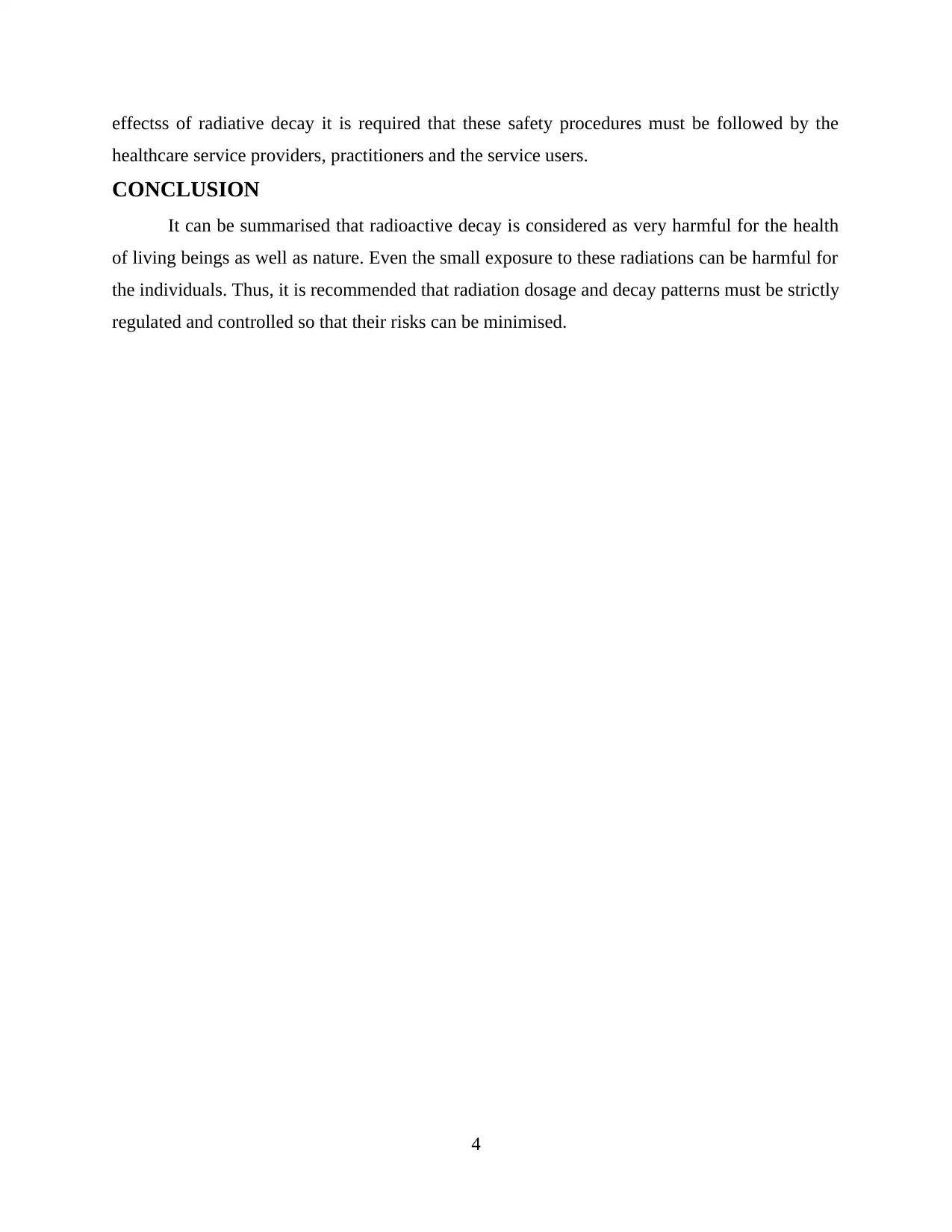
effectss of radiative decay it is required that these safety procedures must be followed by the
healthcare service providers, practitioners and the service users.
CONCLUSION
It can be summarised that radioactive decay is considered as very harmful for the health
of living beings as well as nature. Even the small exposure to these radiations can be harmful for
the individuals. Thus, it is recommended that radiation dosage and decay patterns must be strictly
regulated and controlled so that their risks can be minimised.
4
healthcare service providers, practitioners and the service users.
CONCLUSION
It can be summarised that radioactive decay is considered as very harmful for the health
of living beings as well as nature. Even the small exposure to these radiations can be harmful for
the individuals. Thus, it is recommended that radiation dosage and decay patterns must be strictly
regulated and controlled so that their risks can be minimised.
4
⊘ This is a preview!⊘
Do you want full access?
Subscribe today to unlock all pages.

Trusted by 1+ million students worldwide
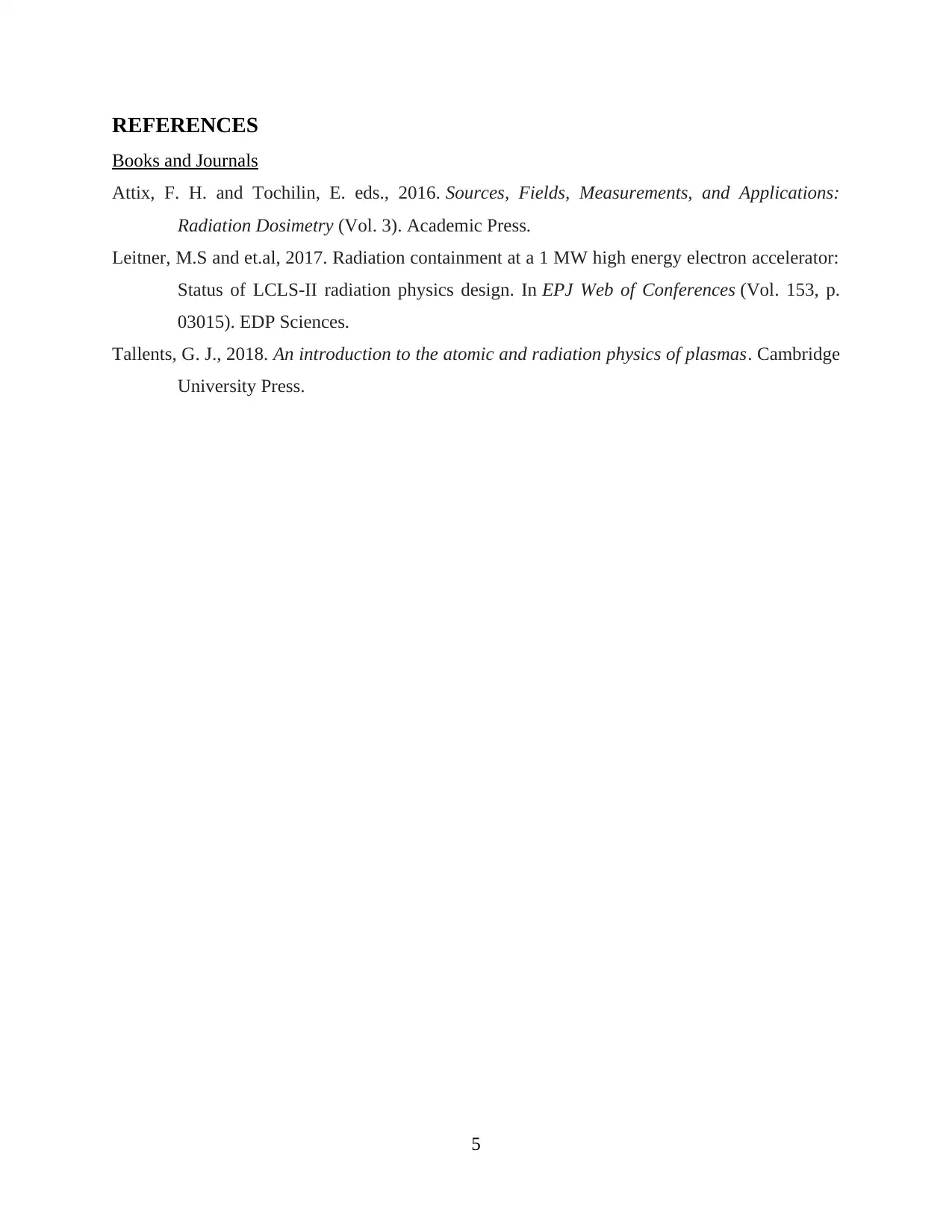
REFERENCES
Books and Journals
Attix, F. H. and Tochilin, E. eds., 2016. Sources, Fields, Measurements, and Applications:
Radiation Dosimetry (Vol. 3). Academic Press.
Leitner, M.S and et.al, 2017. Radiation containment at a 1 MW high energy electron accelerator:
Status of LCLS-II radiation physics design. In EPJ Web of Conferences (Vol. 153, p.
03015). EDP Sciences.
Tallents, G. J., 2018. An introduction to the atomic and radiation physics of plasmas. Cambridge
University Press.
5
Books and Journals
Attix, F. H. and Tochilin, E. eds., 2016. Sources, Fields, Measurements, and Applications:
Radiation Dosimetry (Vol. 3). Academic Press.
Leitner, M.S and et.al, 2017. Radiation containment at a 1 MW high energy electron accelerator:
Status of LCLS-II radiation physics design. In EPJ Web of Conferences (Vol. 153, p.
03015). EDP Sciences.
Tallents, G. J., 2018. An introduction to the atomic and radiation physics of plasmas. Cambridge
University Press.
5
1 out of 7
Related Documents
Your All-in-One AI-Powered Toolkit for Academic Success.
+13062052269
info@desklib.com
Available 24*7 on WhatsApp / Email
![[object Object]](/_next/static/media/star-bottom.7253800d.svg)
Unlock your academic potential
Copyright © 2020–2025 A2Z Services. All Rights Reserved. Developed and managed by ZUCOL.




